Figure 3-9. Company column dismounted.
3-10
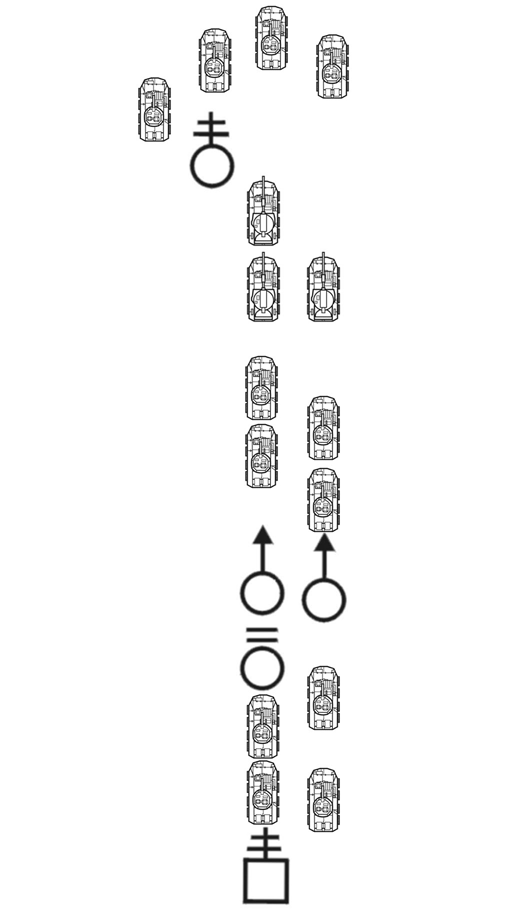
FM 3-21.11
Figure 3-10. Company column mounted.
(2) Company Line. The company line formation puts all platoons forward along the same direction of movement and provides for the delivery of maximum fire to the front, but less to the flanks. It is the most difficult formation to control. The company commander should designate a base platoon (normally the center platoon) for the other platoons to guide on. Flank and rear security is generally poor but is improved when the flank platoons use echelon formations. Figures 3-11 and 3-12, page 3-12, depict examples of the company line.
3-11
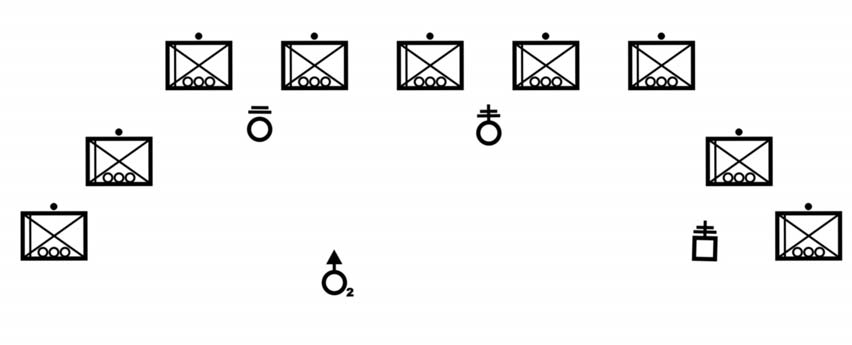
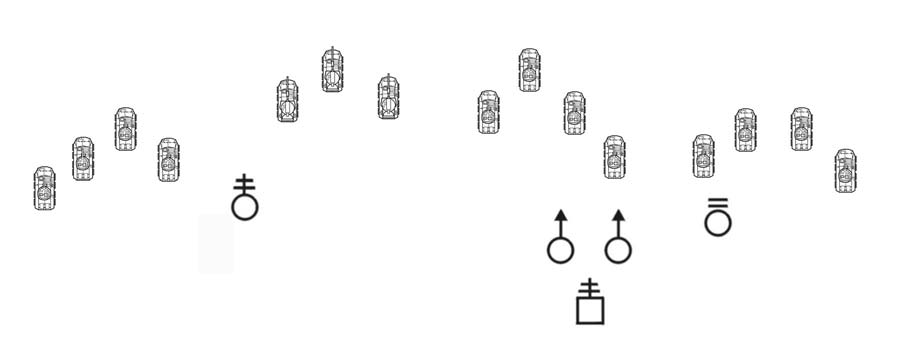
FM 3-21.11
Figure 3-11. Company line dismounted.
Figure 3-12. Company line mounted.
(3) Company Wedge. The company wedge formation allows the commander to make contact with a small element and still maneuver the remaining platoons. If the company is hit from the flank, one platoon is free to maneuver. This formation is hard to control, but it allows faster movement than the company vee formation. Figures 3-13 and 3-14 depict examples of the company wedge.
3-12
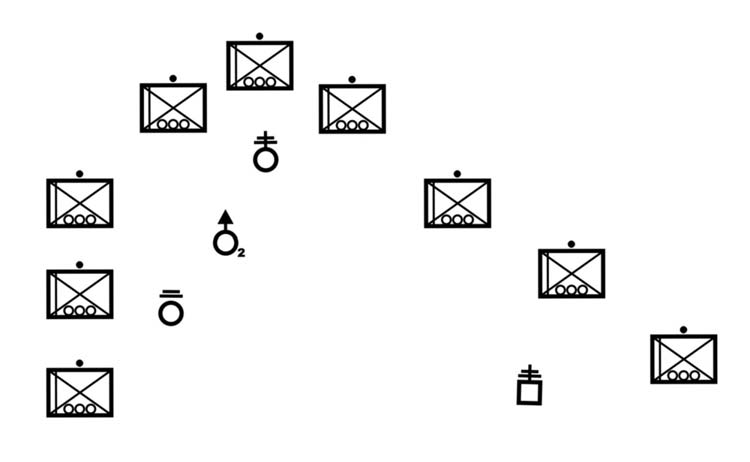
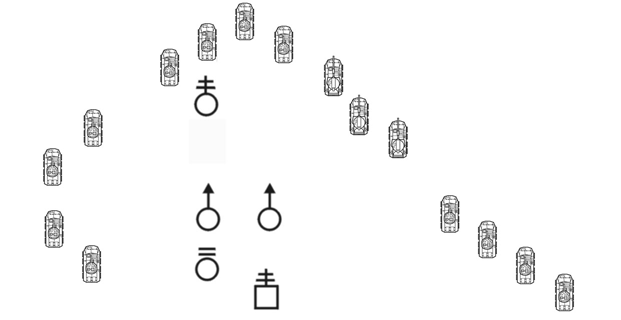
FM 3-21.11
Figure 3-13. Company wedge dismounted.
Figure 3-14. Company wedge mounted.
(4) Company Vee. The company vee formation has two platoons forward to provide immediate fire on contact or to flank the enemy. It also has one platoon in the center and one platoon in the rear. These platoons either overwatch or trail the lead platoons. If the company is hit from either flank, two platoons can provide fire, and at least one platoon is free to maneuver. This formation is hard to control and slows movement. The company commander designates one of the forward platoons as the base platoon. Figures 3-15 and 3-16, page 3-14, depict examples of the company vee with all platoons in wedge.
3-13
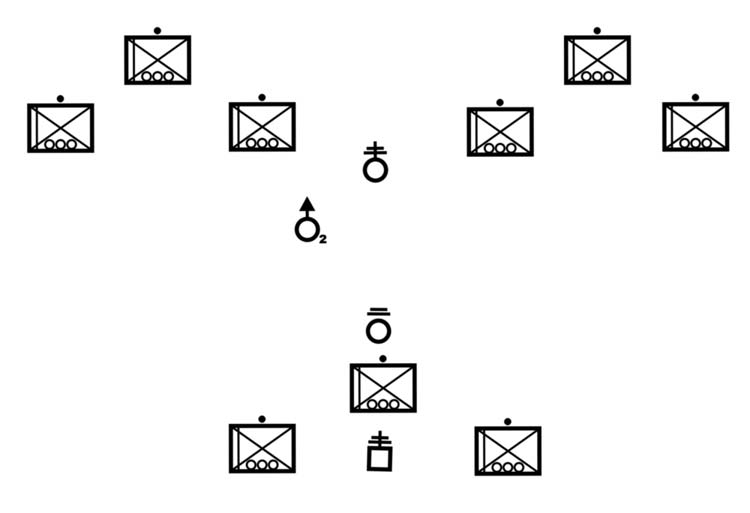
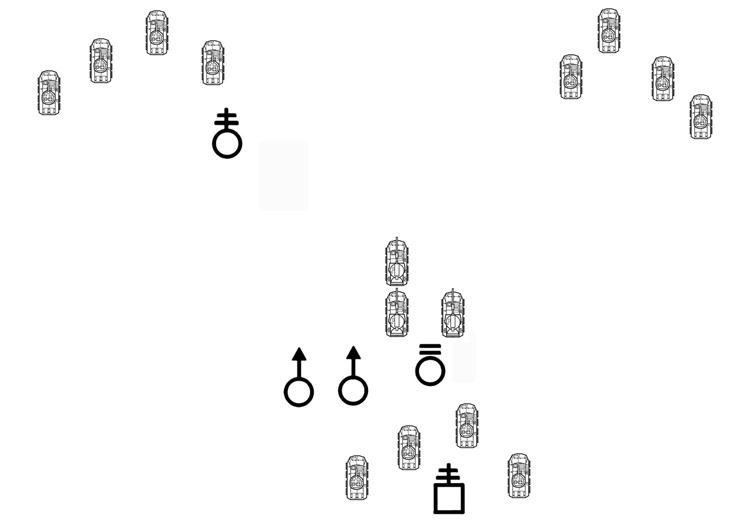
FM 3-21.11
Figure 3-15. Company vee dismounted.
Figure 3-16. Company vee mounted.
(5) Company File. The company file formation is the easiest formation to control. It allows rapid movement in restricted terrain and during limited visibility, and it enhances control and concealment. It is, however, the least secure formation and the hardest from which to maneuver. Figure 3-17 and Figure 3-18, page 3-16, depict examples of the company file with all units in file.
3-14
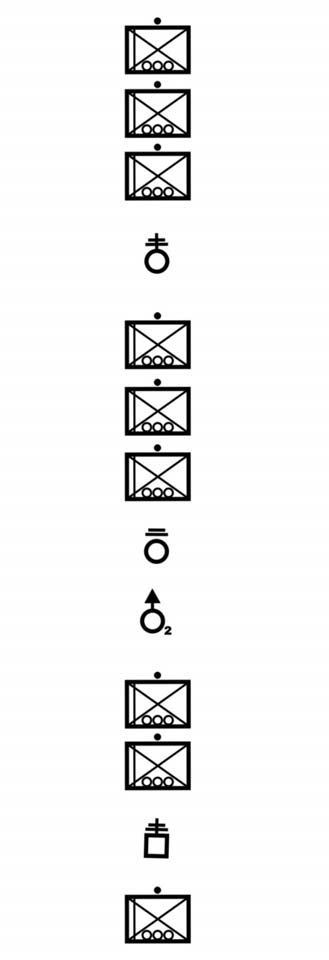
FM 3-21.11
(a) The company commander locates well forward with the lead platoon headquarters or immediately behind the lead security element. This location increases his control by putting him in position to make critical decisions. The company command post can locate farther back (behind the lead platoon) to avoid interfering with the platoon's movement and to aid communications with other elements.
(b) The 1SG (or XO) is last, or nearly last, in the company file to provide leadership and to prevent breaks in contact within the file.
(c) The company file is vulnerable to breaks in contact and should be used only when necessary and for short periods of time. Dismounted, a company stretches out over 600
meters in a company file, with a pass time of more than 20 minutes.
Figure 3-17. Company file dismounted.
3-15
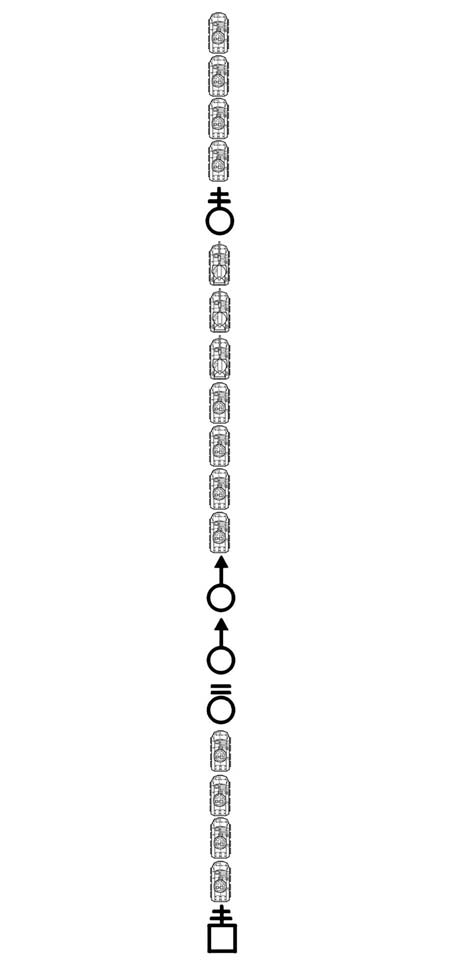
FM 3-21.11
Figure 3-18. Company file mounted.
(6) Echelon Right or Left. The echelon right or echelon left formation is used if the situation is vague and the company commander anticipates enemy contact to the front or on one of the flanks. Normally, an obstacle or another friendly unit exists on the flank of the company opposite the echeloned flank, preventing enemy contact on that side. This formation provides a good volume of fire and protection to the echeloned flank, but less to the opposite flank. Figure 3-19 and Figure 3-20, page 3-18, depict examples of the echelon right formation.
3-16
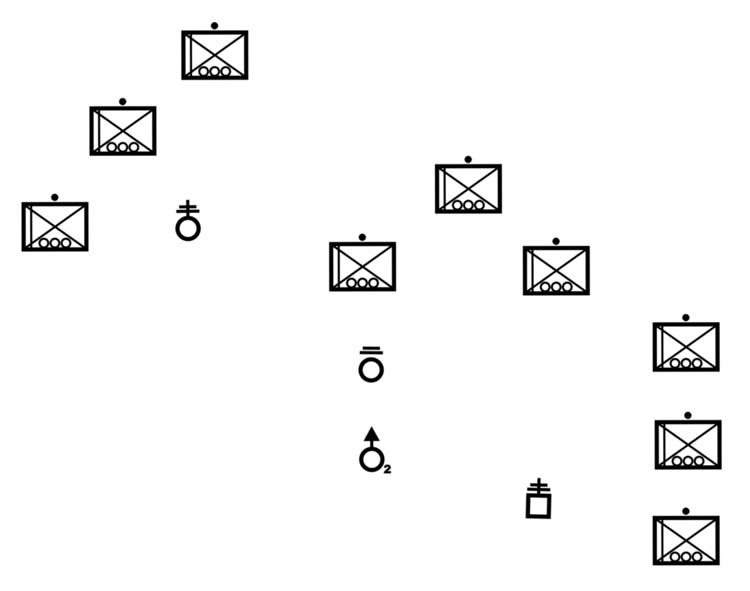
FM 3-21.11
Figure 3-19. Echelon right dismounted.
3-17
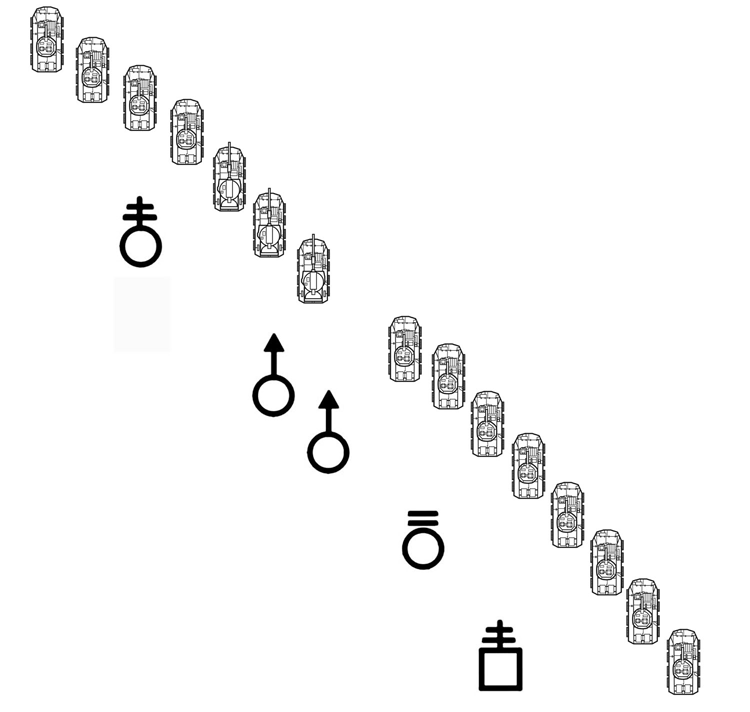
FM 3-21.11
Figure 3-20. Echelon right mounted.
c. Formation Selection. The company commander selects the formation that provides the proper control, security, and speed. Table 3-1 provides a comparison of the six movement formations.
3-18
FM 3-21.11
FORMATION
SECURITY
FIRES
CONTROL
SPEED
• Good dispersion
• Good to front and
• Easy to control
• Fast
rear
Column
• Good 360° security
• Flexible formation
• Excellent to the
flanks
• Excellent to the
• Excellent to the
• Difficult to control
• Slow
front
front
Line
• Inflexible formation
• Poor to the flank
• Poor to the flank
and rear
and rear
• Good 360° security
• Good to the front
• Less difficult to
• Faster
Wedge
and flanks
control than the line
than the
• Flexible formation
line
Vee
• Better to the front
• Very good to the
• Very difficult to
• Slow
front
control
• Least secure
• Poor
• Easy to control
• Fast
File
• Effective use of
concealment
• Good to the
• Good to the
• Difficult to control
• Slow
Echelon
echeloned flank and
echeloned flank and
front
front
Table 3-1. Comparison of movement formations (mounted or dismounted).
3-4.
USE OF MOVEMENT FORMATIONS
Movement should be as rapid as the terrain, the mobility of the force, and the enemy situation permit. The ability to gain and maintain the initiative often depends on undetected movement by the unit. If detected during movement, the enemy may be able to apply substantial combat power against the company. The SBCT infantry company depends heavily upon the terrain for protection from the enemy's fires. The company commander also protects his company during movement by ensuring the company is using proper movement formations and techniques.
a. Fundamentals. The SBCT infantry company commander's mission analysis and information gained through FBCB2 assist him in deciding how to move his unit most effectively. There is no set method for this. When planning company movements, the commander must ensure the unit is moving in a way that supports a rapid transition to maneuver. Once contact with the enemy is made, squads and platoons receiving effective fire execute the appropriate battle drills, and leaders begin to maneuver their units. The following fundamentals provide guidance for planning effective company movements.
(1) Conduct Reconnaissance. All echelons should conduct reconnaissance. The enemy situation and the available planning time may limit the unit's reconnaissance, but leaders at every level must aggressively seek information about the terrain and enemy.
Primarily, this information about the terrain and enemy is gained through FBCB2.
However, if sufficient information is still lacking, an effective technique is to send a reconnaissance element forward of the lead platoon. Even if this unit is only 15 minutes ahead of the company, it can still provide valuable information and reaction time for the company commander.
(2) Use the Terrain and Weather Effectively. One of the strengths of the SBCT
infantry company is its ability to move across almost any terrain and in almost any
3-19
FM 3-21.11
weather conditions. The company should move on covered and concealed routes. Moving during limited visibility may provide better concealment, and the enemy may be less alert during these periods. Plan to avoid identified danger areas.
(3) Move as Squads and Platoon. . The advantages to moving the company by squads and platoons include--
• Faster movement.
• Better security. A small unit is less likely to be detected because it requires less cover and concealment.
• More dispersion. The dispersion gained by moving the company by squads and platoons makes it much more difficult for the enemy to concentrate his fires against the company, especially indirect fires, CAS, and chemical agents.
Subordinate units also gain room to maneuver. Information sharing through the tactical internet makes this a plausible option.
• Better operational security (OPSEC). It is much more difficult for the enemy to determine what the friendly force is doing if all he has are isolated squad-size spot reports.
Although the advantages normally outweigh the disadvantages, when planning decentralized movements the commander should also consider the following disadvantages:
• Requires numerous linkups are required to regroup the company.
• May take longer to mass combat power to support a hasty attack or disengage in the event of enemy contact.
(4) Maintain Security during the Movement. A primary responsibility of the company commander is to protect his unit at all times. This is critical during movement because the company is extremely vulnerable to enemy direct and indirect fires. In addition to the fundamentals listed earlier, the company commander achieves security for the company by applying the following:
• Use the appropriate movement formation and technique for the conditions.
• Move as fast as the situation allows. This may degrade the enemy's ability to detect the unit and the effectiveness of his fires once he detects it.
• Ensure that subordinate units correctly position security elements to the flanks, front, and rear at a distance that prevents enemy direct fire on the main body. (Normally, the company formation and movement technique provides greater security to the front; it is the flanks and rear that must be secured by these security elements. The company SOP should state who is responsible for providing these security elements.)
• Enforce noise and light discipline (especially when dismounted).
• Enforce camouflage discipline (soldiers and their equipment).
• When the situation is not clear, make contact with the smallest element possible. By making contact with a small element, the company commander maintains the ability to maneuver with the majority of his force. The soldiers who first receive enemy fires are most likely to become casualties. They also are most likely to be suppressed and fixed by the enemy.
• When the situation is clear, the company commander must quickly mass the effects of his combat power to overwhelm the enemy.
3-20
FM 3-21.11
b. Locations of Key Leaders and Weapons. The locations of key leaders and weapons depend on the situation, the movement formation and technique, and the organization of the SBCT infantry company. The following paragraphs provide guidance for the company commander in deciding where these assets should locate.
(1) Company Command Post. The company command post normally consists of the company commander, his RATELOs, the FIST, the communications specialist, the NBC
sergeant, and possibly other personnel and attachments (XO, 1SG, or a security element).
The company CP locates where it can best support the company commander and maintain communications with higher and subordinate units. To maintain communications, the mounted CP may need to locate away from the commander. In this case, the XO controls the CP (or part of it) and maintains communications with higher or adjacent units while the commander locates where he can best control the company.
Although the CP can move independently, it normally locates where it is secured by the other platoons and sections within the company formation.
(2) Company Commander. The company commander locates where he can see and control the company. Normally, he positions the CP at his location, but at times he may move separate from the CP. If dismounted, he may take only his company net RATELO
and travel with one of his platoons. This allows him to move with a platoon without disrupting their formation. Generally, the company commander (with the CP) operates immediately behind the lead platoon.
(3) Company Fire Support Officer. The company FSO normally moves with the company commander. At times, he may locate elsewhere to control indirect fires or relay calls for fire from the platoons.
(4) Company Mortars. The company mortars locate where they can provide responsive fires in case of enemy contact. They must locate where they gain security from the other units in the company. They normally are not last in the company formation because they have limited capability to provide security and their soldiers' loads, if dismounted, often make them the slowest element in the company.
(5) Other Attachments. The locations of other attachments depend on METT-TC. CS
assets, such as engineers, are positioned where they can best support the company. For example, the engineers may follow the lead platoon where they can be more responsive.
(6) Infantry Carrier Vehicles, Mobile Gun Systems, and Other Vehicles. The SBCT
infantry company’s ICVs, MGSs and other vehicle attachments, such as ambulances or resupply vehicles, present certain challenges to the SBCT infantry company commander.
The terrain that the infantry company normally moves along after dismounting may not support vehicular movement. It may be possible for the company to secure the roads or trails these vehicles will move on by moving through and securing more restrictive terrain on the flanks. After dismounting, there are several options available to the commander for the disposition of the vehicles. Some of these options are:
• Employ them to support the dismounted infantry.
• Leave them in a lagger site (see Chapter 7, Section IV) with their crews to be called later for linkup.
• Displace them to another location.
• Leave them in place while their crews move dismounted.
3-21
FM 3-21.11
3-5. CONTROL
TECHNIQUES
Using the proper formation and movement techniques assists the SBCT infantry company commander's control of the company, but additional control techniques are often required. The following techniques may help in controlling company movements.
a. Graphics. Normally, the SBCT battalion assigns graphic control measures to integrate the SBCT infantry company's movement into the battalion's movement or scheme of maneuver. The company commander may need to establish other control measures to control his units. These may include boundaries, routes, checkpoints, release points, and target reference points on known (likely) enemy positions to control direct fires. The SBCT company commander ensures that each graphic control measure is updated in FBCB2 and is easy to locate on the terrain.
b. Reconnaissance. Prior reconnaissance aids control during movement. It provides the SBCT infantry company commander with a better idea of where movement is more difficult and where graphic control measures are needed. Elements from the company may perform this reconnaissance, but the RSTA squadron or battalion reconnaissance platoon is more likely to conduct the reconnaissance and provide the information to other organizations through FBCB2.
c. Guides. Guides who have already seen the terrain are the best way to provide control. When it is not possible to have guides for the entire movement, have them reconnoiter the difficult areas and guide the SBCT infantry company through them.
d. Navigational Aids. Even with the availability of a global positioning system (GPS), every leader should use his compass and a pace count for all moves. If possible, select routes that allow leaders to use prominent terrain to stay oriented.
e. Limited Visibility Dismounted Movements. The measures already listed are the best ways to provide control for moving during limited visibility. The following measures provide extra control when moving dismounted in limited visibility.
(1) Use Night Vision Devices. Effective limited visibility movement is possible even if there is not a sufficient quantity of night vision devices (NVDs) for every soldier. If the soldiers providing front, flank, and rear security use them, the entire unit can move faster.
Soldiers should rotate to maintain effectiveness. Key leaders throughout the formation must also use NVDs.
(2) Reduce the Interval between Soldiers and Units. Closing up the formation allows the use of arm-and-hand signals and reduces the chance of breaks in contact. However, leaders should try to maintain the most dispersion possible at all times. Well-trained units can operate at night as they do during the day.
(3) Use Other Measures. Other measures include using luminous tape on the back of helmets, slowing the speed of movement, using land line to communicate or to guide units, and moving leaders closer to the front.
f. Limited Visibility Mounted Movement. Every leader should use the information gained through FBCB2 in addition to his map and compass to remain oriented at all times. If possible, select routes that allow leaders to use prominent terrain to stay oriented. In addition to the capabilities inherent with FBCB2, additional control measures provide unit vehicle integrity during mounted limited visibility movement operations.
(1) Use Night Vision Devices. Effective mounted limited visibility movement is possible if drivers and VCs throughout the formation use NVDs.
3-22
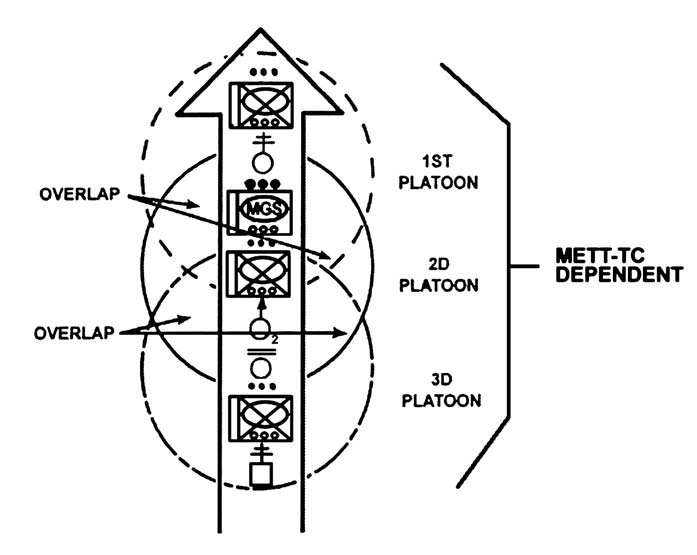
FM 3-21.11
(2) Reduce the Interval between Soldiers, Vehicles, and Units. Closing up the formation allows the use of arm-and-hand signals and reduces the chance of breaks in contact. However, leaders should rely on FBCB2 and night vision equipment to maintain the greatest vehicle dispersion possible at all times. Well-trained units can operate at night as they do during the day.
3-6.
SECURITY DURING MOVEMENT
During company movement, each platoon is responsible for a sector, depending on its position in the formation. When dismounted, each fire team and squad within the platoons has a sector, so the company has all-round security during movement (Figure 3-21).
Figure 3-21. All-round security.
a. During short halts, soldiers spread out and assume prone positions behind cover.
They watch the same sectors they did while moving. Leaders orient machine guns and antiarmor weapons on likely enemy avenues of approach into the position. Soldiers remain alert and keep movement to a minimum. They speak quietly and only when necessary. Soldiers with night vision devices scan areas where the enemy may be concealed during limited visibility.
b. During long halts, the SBCT infantry company sets up a perimeter defense (see Chapter 5). The company commander chooses the most defensible terrain, which must have good cover and concealment. The company SOP must address the actions required during long halts.
c. For additional security, small ambush teams may be concealed and remain in position after a short halt. Ideally, the center platoon provides these teams, which remain
3-23
FM 3-21.11
in position to ambush any enemy following the SBCT infantry company. The linkup of these teams must be coordinated and understood by all.
d. Before occupying a static position (objective rally point, patrol base, or perimeter defense), the SBCT infantry commander should ensure that the enemy is unaware of his company's location. In addition to using the ambush teams, he may also conceal security teams in or near the tentative static position as the company passes it. The company continues movement, preferably until darkness, and then circles back to link up with the security teams, who have reconnoitered the position and guide the company into it.
3-7.
MOVEMENT AS PART OF A BATTALION
The SBCT infantry company often moves as part of the battalion. The battalion commander assigns the company a position within the battalion formation, and the company commander uses the movement technique and movement formation that best suits the likelihood of enemy contact and his unit’s mission. Regardless of the company's position within the battalion formation, it must be ready to make contact or to support the other SBCT infantry companies by maneuver or by fire alone.
3-24
FM
3-21.11
CHAPTER 4
OFFENSIVE OPERATIONS
The SBCT infantry rifle company has great flexibility due to its organic mobility and robust infantry organization. While retaining its light infantry ethos and warfighting capability, it can move faster and farther and can react rapidly to changes in the tactical situation. Thus, this unit is not constrained by the time-space problem that has historically faced the light infantry.
Section I. GENERAL PLANNING CONSIDERATIONS
The outcome of decisive combat derives from offensive actions. All operations are designed to transition to and support the offense. Only through offensive actions can the company accomplish its primary mission--to close with the enemy by means of fire and maneuver to destroy or capture him, or to repel his assault by fire, close combat, and counterattack. A sound doctrinal foundation during offensive planning assists the commander in capitalizing on the increased tactical flexibility of the SBCT infantry rifle company.
4-1.
CHARACTERISTICS OF THE OFFENSE
Traditionally, the characteristics of the offense include surprise,















